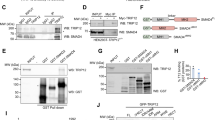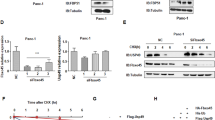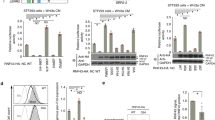Abstract
In gastrointestinal cells, biological signals for transforming growth factor-beta (TGF-β) are transduced through transmembrane serine/threonine kinase receptors that signal to Smad proteins. Smad4, a tumor suppressor, is often mutated in human gastrointestinal cancers. The mechanism of Smad4 inactivation, however, remains uncertain and could be through E3-mediated ubiquitination of Smad4/adaptor protein complexes. Disruption of ELF (embryonic liver fodrin), a Smad4 adaptor protein, modulates TGF-β signaling. We have found that PRAJA, a RING-H2 protein, interacts with ELF in a TGF-β-dependent manner, with a fivefold increase of PRAJA expression and a subsequent decrease in ELF and Smad4 expression, in gastrointestinal cancer cell lines (P<0.05). Strikingly, PRAJA manifests substantial E3-dependent ubiquitination of ELF and Smad3, but not Smad4. Δ-PRAJA, which has a deleted RING finger domain at the C terminus, abolishes ubiquitination of ELF. A stable cell line that overexpresses PRAJA exhibits low levels of ELF in comparison to a Δ-PRAJA stable cell line, where ELF expression is high compared to normal controls. The alteration of ELF and/or Smad4 expression and/or function in the TGF-β signaling pathway may be induced by enhancement of ELF degradation, which is mediated by a high-level expression of PRAJA in gastrointestinal cancers. In hepatocytes, half-life (t1/2) and rate constant for degradation (kD) of ELF is 1.91 h and 21.72 min−1 when coupled with ectopic expression of PRAJA in cells stimulated by TGF-β, compared to PRAJA-transfected unstimulated cells (t1/2=4.33 h and kD=9.6 min−1). These studies reveal a mechanism for tumorigenesis whereby defects in adaptor proteins for Smads, such as ELF, can undergo degradation by PRAJA, through the ubiquitin-mediated pathway.
This is a preview of subscription content, access via your institution
Access options
Subscribe to this journal
Receive 50 print issues and online access
$259.00 per year
only $5.18 per issue
Buy this article
- Purchase on Springer Link
- Instant access to full article PDF
Prices may be subject to local taxes which are calculated during checkout





Similar content being viewed by others
Abbreviations
- RING:
-
Really Interesting New Gene
- TGF-β:
-
transforming growth factor-beta
- ELF:
-
embryonic liver fodrin
- SARA:
-
Smad anchor for receptor activation
- ORF:
-
open-reading frame
- HECT:
-
homologous to E6-AP C-terminus
- HEF1:
-
human enhancer of filamentation 1
- APC:
-
anaphase-promoting complex
- IκB:
-
inhibitor of nuclear factor κB
- PML:
-
promyelocytic leukemia protein
- RFP:
-
ret finger protein
- IAP:
-
inhibitors of apoptosis
- PH:
-
partial hepatectomy
- PBS:
-
phosphate-buffered saline
- BSA:
-
bovine serum albumin
- ATCC:
-
American Type Culture Collection
- HCC:
-
hepatocellular carcinoma
- DMEM:
-
Dulbecco's modified Eagle's medium
- FBS:
-
fetal bovine serum
- IP:
-
immunoprecipitation
- IB:
-
immunoblotting
- FITC:
-
fluorescein isothiocyanate
- SDS:
-
sodium dodecyl sulfate
- ECL:
-
enhanced chemiluminescence
- WB:
-
Western blotting
- SDS–PAGE:
-
SDS–polyacrylamide gel electrophoresis
- VA-1:
-
ELF-specific polyclonal antibody
- HA:
-
hemagglutinin
- R-Smad:
-
receptor-regulated Smad
- PDB:
-
protein data bank
References
Alarcon-Vargas D, Tansey WP, Ronai Z . (2002). Oncogene 21: 4384–4391.
Asano Y, Ihn H, Yamane K, Kubo M, Tamaki K . (2004). J Clin Invest 113: 253–264.
Bhanumathy CD, Tang Y, Monga SP, Katuri V, Cox JA, Mishra B et al. (2002). Dev Dyn 223: 59–69.
Bonni S, Wang HR, Causing CG, Kavsak P, Stroschein SL, Luo K et al. (2001). Nat Cell Biol 3: 587–595.
Braun L, Mead JE, Panzica M, Mikumo R, Bell GI, Fausto N . (1988). Proc Natl Acad Sci USA 85: 1539–1543.
Brzovic PS, Meza J, King MC, Klevit RE . (1998). J Biol Chem 273: 7795–7799.
Chatterjee-Kishore M, van Den Akker F, Stark GR . (2000). J Biol Chem 275: 20406–20411.
Chen D, Kon N, Li M, Zhang W, Qin J, Gu W . (2005). Cell 121: 1071–1083.
Derynck R, Zhang YE . (2003). Nature 425: 577–584.
Dinudom A, Harvey KF, Komwatana P, Young JA, Kumar S, Cook DI . (1998). Proc Natl Acad Sci USA 95: 7169–7173.
Dupont S, Zacchigna L, Cordenonsi M, Soligo S, Adorno M, Rugge M et al. (2005). Cell 121: 87–99.
Ebisawa T, Fukuchi M, Murakami G, Chiba T, Tanaka K, Imamura T et al. (2001). J Biol Chem 276: 12477–12480.
Fukuchi M, Imamura T, Chiba T, Ebisawa T, Kawabata M, Tanaka K et al. (2001). Mol Biol Cell 12: 1431–1443.
Heldin C-H, Miyazono K, ten Dijke P . (1997). Nature 390: 465–471.
Hicke L, Dunn R . (2003). Annu Rev Cell Dev Biol 19: 141–172.
Honda R, Yasuda H . (1999). EMBO J 18: 22–27.
Itoh S, Thorikay M, Kowanetz M, Moustakas A, Itoh F, Heldin C-H et al. (2003). J Biol Chem 278: 3751–3761.
Izzi L, Attisano L . (2004). Oncogene 23: 2071–2078.
Janse DM, Crosas B, Finley D, Church GM . (2004). J Biol Chem 279: 21415–21420.
Joazeiro CA, Wing SS, Huang H, Leverson JD, Hunter T, Liu YC . (1999). Science 286: 309–312.
Kavsak P, Rasmussen RK, Causing CG, Bonni S, Zhu H, Thomsen GH et al. (2000). Mol, Cell 6: 1365–1375.
Koepp DM, Harper JW, Elledge SJ . (1999). Cell 97: 431–434.
Kretzschmar M, Massague J . (1998). Curr Opin Genet Dev 8: 103–111.
Laney JD, Hochstrasser M . (1999). Cell 97: 427–430.
Li M, Brooks CL, Wu-Baer F, Chen D, Baer R, Gu W . (2003). Science 302: 1972–1975.
Liu X, Elia AE, Law SF, Golemis EA, Farley J, Wang T . (2000). EMBO J 19: 6759–6769.
Lorick KL, Jensen JP, Fang S, Ong AM, Hatakeyama S, Weissman AM . (1999). Proc Natl Acad Sci USA 96: 11364–11369.
Markowitz SD, Roberts AB . (1996). Cytokine Growth Factor Rev 7: 93–102.
Mishra L, Cai T, Levine A, Weng D, Mezey E, Mishra B et al. (1998). Int J Dev Biol 42: 221–224.
Mishra L, Cai T, Yu P, Monga SP, Mishra B . (1999). Oncogene 18: 353–364.
Mishra L, Tully RE, Monga SP, Yu P, Cai T, Makalowski W et al. (1997). Oncogene 15: 2361–2368.
Miyazono K, Suzuki H, Imamura T . (2003). Cancer Sci 94: 230–244.
Moser MJ, Gong Y, Zhang MN, Johnston J, Lipschitz J, Minuk GY . (2001). Dig Dis Sci 46: 907–914.
Ohta T, Michel JJ, Schottelius AJ, Xiong Y . (1999). Mol Cell 3: 535–541.
Pan Y, Haines DS . (1999). Cancer Res 59: 2064–2067.
Roberts AB, Sporn MB . (1990). Peptide growth factors and their receptors. In: Handbook of Experimental Pathology, Sporn MB, Roberts AB (eds). Springer-Verlag: New York, pp. 419–472.
Russell WE, Coffey Jr RJ, Ouellette AJ, Moses HL . (1988). Proc Natl Acad Sci USA 85: 5126–5130.
Sasaki A, Masuda Y, Iwai K, Ikeda K, Watanabe K . (2002). J Biol Chem 277: 22541–22546.
Saurin AJ, Borden KL, Boddy MN, Freemont PS . (1996). Trends Biochem Sci 21: 208–214.
Schwartz DC, Hochstrasser M . (2003). Trends Biochem Sci 28: 321–328.
Schwede T, Kopp J, Guex N, Peitsch MC . (2003). Nucleic Acids Res 31: 3381–3385.
Shi Y, Massague J . (2003). Cell 113: 685–700.
Siegel PM, Massague J . (2003). Nat Rev Cancer 3: 807–821.
Souchelnytskyi S, Moustakas A, Heldin C-H . (2002). Trends Cell Biol 12: 304–307.
Stroschein SL, Bonni S, Wrana JL, Luo K . (2001). Genes Dev 15: 2822–2836.
Sun Y . (2003). Cancer Biol Ther 2: 623–629.
Tang B, Vu M, Booker T, Santner SJ, Miller FR, Anver MR et al. (2003a). J Clin Invest 112: 1116–1124.
Tang Y, Katuri V, Dillner A, Mishra B, Deng CX, Mishra L . (2003b). Science 299: 574–577.
Tang Y, Katuri V, Iqbal S, Narayan T, Wang Z, Lu RS et al. (2002). Oncogene 21: 5255–5267.
Tang Y, Katuri V, Srinivasan R, Fogt F, Redman R, Anand G et al. (2005). Cancer Res 65: 9228–9237.
Wang T . (2003). Front Biosci 8: d1109–d1127.
Weinstein M, Monga SP, Liu Y, Brodie SG, Tang Y, Li C et al. (2001). Mol Cell Biol 21: 5122–5131.
Weinstein M, Yang X, Deng C . (2000). Cytokine Growth Factor Rev 11: 49–58.
Wieser R . (2001). Curr Opin Oncol 13: 70–77.
Xu J, Attisano L . (2000). Proc Natl Acad Sci USA 97: 4820–4825.
Xu X, Brodie SG, Yang X, Im YH, Parks WT, Chen L et al. (2000). Oncogene 19: 1868–1874.
Yang X, Letterio JJ, Lechleider RJ, Chen L, Hayman R, Gu H et al. (1999). EMBO J 18: 1280–1291.
Yin Y, Wang ZY, Mora-Garcia S, Li J, Yoshida S, Asami T et al. (2002). Cell 109: 181–191.
Zhang Y, Chang C, Gehling DJ, Hemmati-Brivanlou A, Derynck R . (2001). Proc Natl Acad Sci USA 98: 974–979.
Zhang Y, Musci T, Derynck R . (1997). Curr Biol 7: 270–276.
Zhong Q, Gao W, Du F, Wang X . (2005). Cell 121: 1085–1095.
Zhu H, Kavsak P, Abdollah S, Wrana JL, Thomsen GH . (1999). Nature 400: 687–693.
Acknowledgements
We thank Drs M Zasloff and S Evans for their critical review of the manuscript, and R Redman and A Rashid for their invaluable assistance with histopathology specimens and extensive confirmatory review of all slides. Grant Support: NIHR01 DK56111 (LM), NIHR01 CA106614-01A2 (LM), NIHR01 DK58637 (BM), VA Merit Award (LM), and R Robert and Sally D Funderburg Research Scholar (LM).
Author information
Authors and Affiliations
Corresponding authors
Additional information
Competing interest statement
The authors have no competing financial interests.
Supplementary Information accompanies the paper on Oncogene website (http://www.nature.com/onc)
Supplementary information
Rights and permissions
About this article
Cite this article
Saha, T., Vardhini, D., Tang, Y. et al. RING finger-dependent ubiquitination by PRAJA is dependent on TGF-β and potentially defines the functional status of the tumor suppressor ELF. Oncogene 25, 693–705 (2006). https://doi.org/10.1038/sj.onc.1209123
Received:
Revised:
Accepted:
Published:
Issue Date:
DOI: https://doi.org/10.1038/sj.onc.1209123
Keywords
This article is cited by
-
Norepinephrine transport-mediated gene expression in noradrenergic neurogenesis
BMC Genomics (2009)



